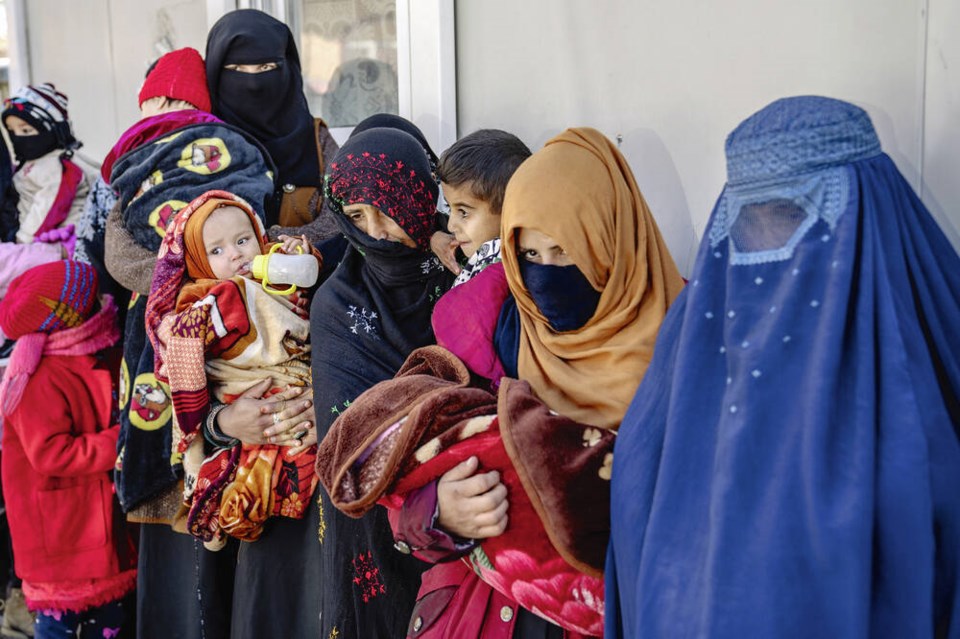Courtesy of the Times Colonist
Photo: Mothers and babies suffering from malnutrition wait to receive help in Kabul, Afghanistan in January. Women under the Taliban regime in Afghanistan are denied education and employment. Ebrahim Noroozi, AP
Last week, I discussed the need for a reduction in inequality within nations as the second of five “great turnarounds’” proposed in the Earth For All report.
The third turnaround needed to ensure a socially just transformation is the empowerment of women and the achievement of gender equity.
The report’s authors stress the need for improvement in “women’s access to education, economic opportunities and dignified jobs, and all life’s chances that these bring.” The education and empowerment of women and their involvement in the economy, they note, is strongly linked to reduced fertility rates and a reduction in population size.
This point was emphasized by Per Espen Stoknes, Earth For All project lead and director of the Centre for Sustainability at the Norwegian Business School. It is the main factor behind their prediction that the population would peak at 8.6 billion in 2050 (we just passed 8 billion) before declining to 7 billion in 2100.
Gender equality is the fifth of the UN’s 17 Sustainable Development Goals agreed upon by all the nations of the world, including Canada, in 2015.
There are six outcome targets under this goal, including ending all forms of discrimination against women and girls; ending violence and exploitation of women and girls; eliminating harmful practices such as forced marriage and female genital mutilation; and ensuring access to universal reproductive rights and health.
The latest report on Goal 5 from UN Women, the UN organization dedicated to gender equality and the empowerment of women, was in 2022. It found “the world is not on track to achieve gender equality by 2030.”
Indeed, at the current rate of change, the report noted, “it may take another 286 years to remove discriminatory laws and close prevailing gaps in legal protections for women and girls.”
The report highlights the importance of educating girls and young women, noting it is “integral to virtually every aspect of development, including economic growth and prosperity.”
These benefits, decades of research has shown, include “faster poverty reduction, better maternal health, lower child mortality, greater HIV prevention and reduced violence against women.”
A fact sheet in the report highlights that violence against women and girls remains commonplace. Shockingly, globally, one woman or girl is killed by someone in her own family every 11 minutes, while globally, one in eight women and girls aged 15-49 was subjected to sexual and/or physical violence by an intimate partner in the previous year.
Clearly there is a long way to go in achieving gender equality in many parts of the world, as highlighted by recent events in Afghanistan, in which women are denied education and employment, or in Iran, where there are many restrictions on women; similar restrictions are seen in many other parts of the world.
Here in Canada, not only is gender equality a fundamental human right, the Government of Canada states that it is “a necessary foundation for a peaceful, prosperous and sustainable world.” As part of its commitment, in 2019, the government established a Ministry of Women and Gender Equality.
Canada’s aims, according to the federal government, are to eliminate gender-based violence and harassment, support gender equality in leadership roles and at all levels of decision-making and ensure that Canadians, and those who live here, share responsibilities within households and families.
The federal government introduced the Gender Results Framework in 2018 to provide data on gender equality within six main areas: education and skills development; economic participation and prosperity; leadership and democratic participation; gender-based violence and access to justice; poverty reduction, health and well-being; and gender equality around the world.
Regrettably, however, while there is lots of data in extensive tables, it is not user-friendly and I could not find a useful summary or compilation on their website, nor could I find an annual report.
However, the Canadian Women’s Foundation notes that women working full-time and part-time make 89 cents for every dollar men make, that women, especially single mothers, are more likely to live in low-income households than men, and that one in 10 women are concerned about the possibility of violence in the home.
Clearly, we are far from gender equality globally, and still have some way to go in Canada.
thancock@uvic.ca
Dr. Trevor Hancock is a retired professor and senior scholar at the University of Victoria’s School of Public Health and Social Policy
